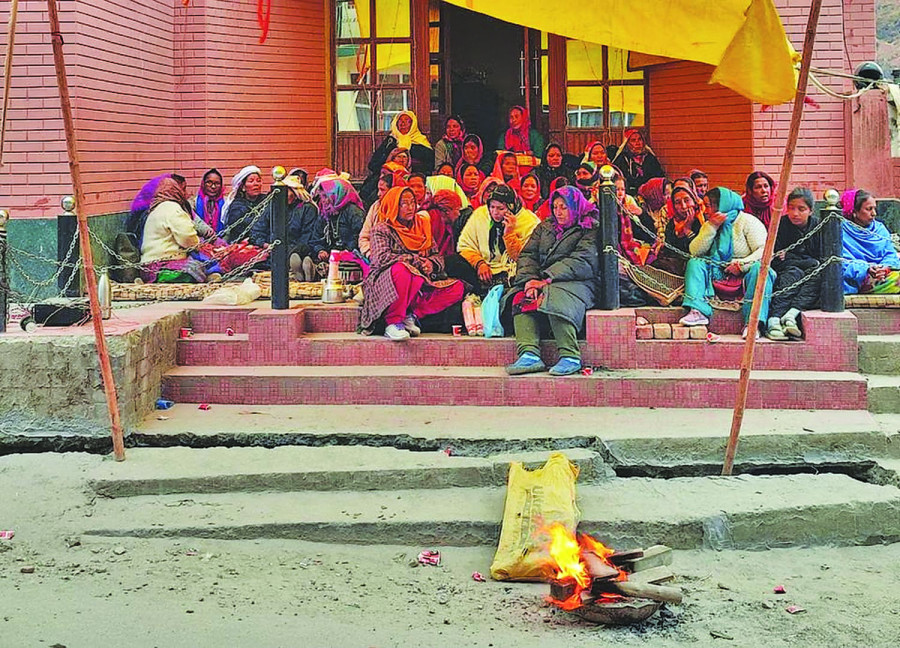Columns
In Uttarakhand land sinking, a forewarning
As we build roads and power projects in the fragile mountains, dangerous consequences await us.
Madhukar Upadhya
If landslides, floods, droughts and food insecurity were recurring annual problems for the mountain people, such disasters are now being exacerbated by the impacts of climate change. The sinking of settlements has added to these woes. The gradual sinking of Joshimath, an important mountain town in Uttarakhand, India, with around 25,000 residents, made headlines in the first week of this year. Situated on an unconsolidated geological deposit on the banks of the Dhauliganga and the Alaknanda, the two major sources of the River Ganga in Uttarakhand, Joshimath is a gateway and an overnight stay point for pilgrims visiting the holy shrines of Badrinath and Hemkumd Shahib, and for tourists visiting Auli.
In the early hours of January 2, residents in several buildings were awoken by the sounds of cracks that had developed in the buildings, pavements, farms and surrounding areas including roads. The development of cracks had been reported in the past, but this time they progressed rapidly. On that day, some 670 houses were reported to have developed multiple cracks of various widths. Water started to gush out of farms. Buildings started to tilt. It was a clear sign that part of the town was subsiding.
While not as severe as Joshimath, cracks have also been reported in the faraway towns of Mussourie, Uttarkasi and Bhatwari to the west, and Gopeshwar and Karnprayag to the south of Joshimath. The widespread subsidence taking place in Uttarakhand should send alarm bells ringing, and compel us to ask ourselves some serious questions: How safe are mountain settlements that have been expanding rapidly in recent years, and how sustainable is it to build heavy infrastructures across the mountain slopes and valleys given the fragility of the Himalaya, a young and growing mountain range with multiple fault lines?
Mountain subtleties
Though it may take us a while to find the actual cause of the subsidence, preliminary assessments indicate that it happened due to a combination of factors including continuing expansion of the town with the construction of wider roads at the toes of the mountain, heavy structures and tunnels being dug for roads and hydropower plants. In February 2021, a massive flood had already hit the area, damaging the Dhauliganga dam and impacting the under-construction tunnel of another hydropower project.
The fear now is that what happened in Uttarakhand may repeat anywhere across the Himalaya where heavy infrastructure is being built without considering the inherent land capacity to withstand the pressure and ongoing changes in hydrological networks caused by human interventions, especially along the fault lines. However, the construction of hydropower plants and roads will continue to expand in the mountains to meet the growing demand for power and connectivity. Being a mountainous country, the Joshimath disaster should be a stark warning for Nepal, especially considering how we are expanding road networks in the mountains and building hydropower plants for clean energy against the backdrop of a warming atmosphere and changing precipitation patterns.
While building infrastructure, we often forget that mountains aren’t static bodies, rather they're a composite of various dynamic systems that keep changing continually: Changes caused by floods, landslides and sometimes earthquakes are visible instantly in the landscape, but not the changes they cause to the hydrological regime, crucial for slope stability. Glacial and landslide deposits are inherently prone to such changes. Changes, such as weathering of rocks or surcharges added by growing vegetation, are only visible after a long time.
Small streams, such as the Jhiku Khola in Panchkhal, Kabhre, have disappeared in the last three decades for unknown reasons. Drying springs, a recent phenomenon, are probably a similar long-term change that we don’t fully understand yet. Often, very little information is available about these long-term changes taking place over a small area. We hear people's grievances when landslides occur in places where they hadn't occurred in centuries. The massive landslide of Jure or that of Ramche are distinct examples.
In recent years, the Himalaya has been warming and such changes are happening faster because mountain systems are amongst the most dynamic on earth and sensitive to climate change. The irony is that the decisions to expand infrastructure projects are mostly based on political decisions rather than technical reasons that consider immediate and future consequences. Again, Joshimath shows us what can go wrong. There were already a number of hydroelectric power projects and networks of roads being built around the town. Tunnels were dug for hydropower, rail and road projects, one of which also passes through the area below the town. In 2014, a year after unprecedented floods and landslides that killed more than 6,000 people and damaged infrastructure in the area, experts advised against building dams in valleys above 7,000 feet. Experts also advised not to build wide roads. However, hydropower dams and 10-metre-wide highways were built.
Key lessons
These events bring with them new layers of concerns regarding the Himalaya. What has become evident is that, unlike in the Alps in Europe or Aravalli in India, big infrastructure may not be appropriate on the fragile mountains of the Himalaya. The exploitation of mountains for economic development has limitations, and should only be done after considering the risks involved both in the short and long terms. A clear example is the boreholes that the government is promoting to extract groundwater in the mountains. No one asks questions about groundwater extraction when it's dug to provide water to areas where springs have dried. However, how many of them have been done after a detailed study of the potential risks involved? It could very well prove to be a maladaptation in the longer term. Therefore, they should be pursued with extra precautions in areas where settlements are on landslide deposits; most of our mountain settlements are located on such landslide deposits.
A vital lesson here is to listen to the experts irrespective of where they come from when it comes to using the natural environment for infrastructure development. Governments should listen to the advice of experts. However, what we hear is often the opposite. The new prime minister, while seeking a vote of confidence in Parliament, announced that the government would go ahead with its previous plan to build Nijgadh Airport despite the Supreme Court’s order and opposition from experts against large-scale destruction of natural forests for its construction.
We should seriously consider the message coming out of Joshimath before we make decisions for large-scale interventions in the fragile mountain ecosystems. Precious lives, livelihoods and landscapes are at risk of irreversible damage the longer we allow such obdurate decision-making to continue.




 12.12°C Kathmandu
12.12°C Kathmandu















